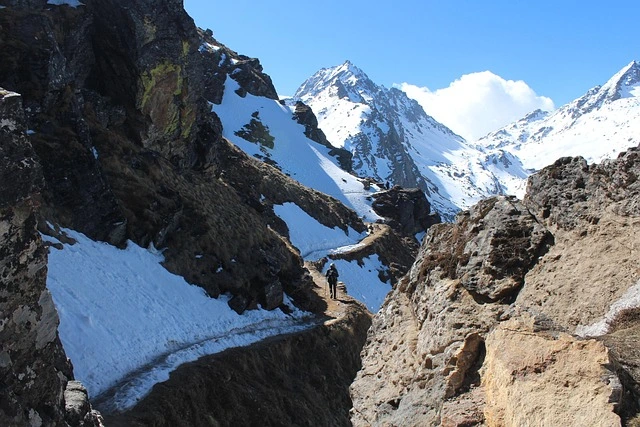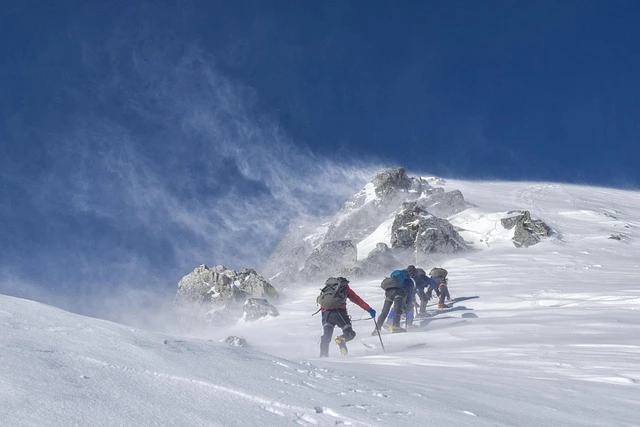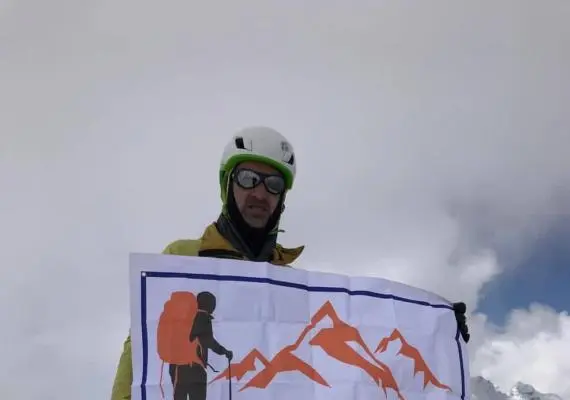Imagine standing at 4,800 meters, surrounded by glaciers and towering peaks, with the eighth-highest mountain in the world rising directly above you. This is the reality of reaching Manaslu Base Camp, one of Nepal's most spectacular yet lesser-known trekking destinations.
The Manaslu region offers what the crowded trails of Everest and Annapurna once provided decades ago—raw, authentic Himalayan trekking through restricted areas where ancient Tibetan Buddhist culture thrives, untouched by mass tourism.
Here's what most trekkers don't realize: When you search for "Manaslu Base Camp Trek," you're actually looking at the famous Manaslu Circuit Trek. The base camp itself is a breathtaking day hike from Samagaon village during this circuit adventure. This confusion exists across most trekking websites, but we'll clarify everything you need to know for your 2026 trek.
Unlike the tourist highways of other popular routes, the Manaslu region limits access through special permits and mandatory guides, preserving its pristine beauty and authentic mountain culture. With only 2,000 trekkers annually compared to tens of thousands elsewhere, this is Nepal's best-kept trekking secret.
Manaslu Base Camp Trek Overview
The Manaslu Base Camp Trek combines challenging high-altitude trekking with intimate cultural encounters in one of Nepal's most restricted regions. This 12-16 day adventure circles the massive Manaslu massif, crossing the spectacular Larkya La Pass at 5,160 meters.
Quick Facts About Manaslu Base Camp Trek:
- Total Duration: 12-16 days
- Maximum Altitude: 5,160m (Larkya La Pass)
- Base Camp Altitude: 4,800m
- Total Distance: 177 kilometers
- Difficulty: Moderate to Strenuous
- Permits Required: RAP, MCAP, ACAP, TIMS
- Best Seasons: Spring (March-May) and Autumn (September-November)
- Starting Point: Machha Khola (870m)
- Ending Point: Dharapani (1,860m)
The route follows ancient salt trading paths along the Budhi Gandaki River, ascending through subtropical forests into alpine terrain. You'll pass through traditional villages where time seems frozen, visit ancient monasteries, and experience the warm hospitality of the Nubri people.
The highlight for many is the optional day hike to Manaslu Base Camp from Samagaon village—a challenging but rewarding excursion that brings you face-to-face with the world's eighth -highest peak. This acclimatization hike offers spectacular views of the Manaslu Glacier and surrounding peaks that few trekkers ever witness.
Manaslu Base Camp vs Manaslu Circuit Trek — What's the Difference?
Let's clear up the biggest confusion in Manaslu trekking: Manaslu Base Camp Trek and Manaslu Circuit Trek are essentially the same journey. The base camp itself is not a separate trek but rather an optional day hike during the circuit.
Here's what you need to know:
The Reality:
- Both names refer to the same 12-16 day circuit around Manaslu
- The base camp visit is a day excursion from Samagaon
- You cannot trek directly to just the base camp—you must do the full circuit
- Most itineraries include the base camp hike as an acclimatization activity
Key Comparisons:
Manaslu Circuit (Without Base Camp Hike):
- Duration: 12-14 days
- Highest Point: Larkya La Pass (5,160m)
- Focus: Complete circuit, cultural villages, pass crossing
- Difficulty: Moderate to Strenuous
Manaslu Circuit (With Base Camp Hike):
- Duration: 13-16 days (adds 1 day)
- Highest Point: Still Larkya La Pass (5,160m)
- Additional Altitude: Base Camp at 4,800m
- Extra Distance: 13km round trip
- Difficulty: Slightly more strenuous due to extra altitude gain
The base camp excursion adds incredible value—you'll see Manaslu's north face up close, visit glacial lakes, and gain better acclimatization before crossing Larkya La Pass. However, it's not essential for completing the circuit trek.
Manaslu Base Camp Trek Permits and 2026 Rules Update
Major 2026 Update: Solo trekking is now completely banned in the Manaslu region. You must trek with at least one other person, plus a licensed guide.
Required Permits:
- Manaslu Restricted Area Permit (RAP/MRAP)
- Cost: USD 100/week (Sept-Nov) or USD 75/week (Dec-Aug)
- Additional days: USD 15/day (peak) or USD 10/day (off-peak)
- Covers: Jagat to Dharapani restricted zones
- Manaslu Conservation Area Permit (MCAP)
- Cost: USD 30 per person
- Validity: Entire trek duration
- Purpose: Conservation funding
- Annapurna Conservation Area Permit (ACAP)
- Cost: USD 30 per person
- Required for: Dharapani to Besisahar section
- TIMS Card (NEW for 2026)
- Cost: USD 20 per person
- Status: Now mandatory for the Manaslu region
- Purpose: Trekker safety and tracking
Total Permit Costs:
- Peak Season: USD 230-250
- Off Season: USD 205-225
Where to Obtain Permits:
- Nepal Tourism Board, Kathmandu
- Through registered trekking agencies only
- Processing time: 1-2 working days
Required Documents:
- Valid passport (6+ months validity)
- Nepal visa
- 4 passport photos
- Travel insurance details
- Detailed itinerary
2026 Regulatory Changes:
- Minimum group size: 2 trekkers + 1 guide
- Solo trekking prohibited
- Online permit applications now available
- Stricter checkpoint enforcement
Manaslu Base Camp Trek Cost Breakdown (2026)
Budget Trek (USD 575-900 per person):
- Basic teahouse accommodation
- Three meals daily (dal bhat focused)
- Licensed guide service
- All permits included
- Local bus transportation
Standard Trek (USD 1,000-1,500 per person):
- Better teahouse selection
- Varied meal options
- Experienced guide
- Porter service (2:1 ratio)
- Private jeep transportation option
Premium Trek (USD 1,500-2,500 per person):
- Best available lodges
- Private guide and porter
- Flexible itinerary
- Private transportation throughout
- Additional services (satellite phone, first aid kit)
Cost Components:
Permits: USD 205-250
- RAP: USD 100-175
- MCAP: USD 30
- ACAP: USD 30
- TIMS: USD 20
Guide: USD 25-35/day
- Total: USD 300-450 for trek
Porter: USD 20-25/day
- Total: USD 240-300 (optional)
Accommodation: USD 5-10/night
Meals: USD 20-30/day
Transportation:
- Bus: USD 30-40 round trip
- Jeep: USD 300-400 round trip
Additional Expenses:
- Hot showers: USD 2-5 each
- WiFi: USD 2-5 per use
- Charging: USD 2-4 per device
- Bottled water: USD 2-5 per liter
- Tips: 10% of the total cost
Trek Difficulty, Altitude, and Fitness Requirements
The Manaslu Base Camp Trek ranks as moderate to strenuous, requiring good physical fitness and mental preparation. Here's what you need to know:
Physical Demands:
- Daily walking: 5-8 hours
- Distance per day: 15-22 km
- Elevation gains: 400-800m daily
- Challenging terrain: steep ascents, rocky paths, river crossings
The Base Camp Day Challenge: The hike to Manaslu Base Camp adds extra difficulty:
- Single-day elevation gain: 1,270m
- Round trip: 6-8 hours
- Terrain: Steep, loose moraine, glacial debris
- No facilities en route
Altitude Considerations:
- Trek starts: 870m
- Highest sleeping: 4,460m (Dharamsala)
- Highest point: 5,160m (Larkya La Pass)
- Base Camp: 4,800m
Altitude Sickness Prevention:
- Ascend gradually (max 500m/day above 3,000m)
- Stay hydrated (3-4 liters daily)
- Include 2 acclimatization days
- Consider Diamox (consult doctor)
- Known symptoms: headache, nausea, fatigue
Fitness Requirements:
- Cardiovascular endurance essential
- Leg strength for steep climbs
- Core stability for rough terrain
- Previous hiking experience helpful
Training Recommendations:
- Start 2-3 months before the trek
- Focus on hiking, stair climbing, and cycling
- Build to 5-6 hours of continuous activity
- Practice with a loaded backpack
- Include hill/stair training
Best Time to Trek to Manaslu Base Camp
Spring Season (March-May): Pros:
- Clear mountain views
- Rhododendron forests in bloom
- Warmer temperatures
- Stable weather patterns
Cons:
- Occasional afternoon clouds
- Busier trails (though still quiet)
- Higher prices
Best Spring Month: April offers a perfect balance of clear skies and comfortable temperatures
Autumn Season (September-November): Pros:
- Crystal clear skies
- Best mountain visibility
- Stable weather
- Festival season (Dashain/Tihar)
Cons:
- Colder nights
- Peak season prices
- More trekkers on the trail
Best Autumn Month: October provides ideal conditions with minimal precipitation
Winter Season (December-February): Pros:
- Solitude on trails
- Clear views
- Lower prices
Cons:
- Extreme cold (-15°C at altitude)
- Snow blocks Larkya La Pass
- Some teahouses closed
- Challenging conditions
Monsoon Season (June-August): Pros:
- Lush green landscapes
- Fewer trekkers
- Lower costs
Cons:
- Heavy rainfall
- Leeches in the lower sections
- Landslide risks
- Poor visibility
- Not recommended
Monthly Weather Overview:
March: Cold but clearing, snow possible at pass April: Ideal conditions, rhododendrons blooming May: Warm but occasional clouds June-August: Monsoon - avoid September: Post-monsoon clarity emerging October: Perfect conditions, peak season November: Cold but clear, excellent visibility December-February: Very cold, snow likely
Accommodation, Food, and Facilities on the Trail
Teahouse Accommodation: The Manaslu trail offers basic but comfortable teahouses throughout:
Room Types:
- Twin sharing with basic beds
- Foam mattresses and pillows provided
- Blankets available (bring sleeping bag)
- Shared bathrooms (mostly squat toilets)
- No heating in rooms
Facilities by Altitude:
- Below 3,000m: Hot showers, charging, basic WiFi
- 3,000-4,000m: Limited hot water, expensive charging
- Above 4,000m: Basic facilities only
Food Options:
Standard Menu Items:
- Dal Bhat (unlimited refills): USD 5-10
- Noodle/pasta dishes: USD 4-8
- Fried rice varieties: USD 4-8
- Pancakes/porridge: USD 3-6
- Tea/coffee: USD 2-4
Special at Samagaon: Samagaon offers the best facilities before the pass:
- Several lodge options
- Bakery with fresh items
- Hot showers available
- Charging stations
- Limited internet
Base Camp Day Logistics:
- Pack lunch from Samagaon lodge
- Carry 3-4 liters of water
- No facilities at base camp
- Return to Samagaon for overnight
Hygiene Tips:
- Bring hand sanitizer
- Use water purification
- Avoid meat above 3,000m
- Stick to vegetarian options
- Boil or treat all drinking water
Cultural and Scenic Highlights
Tibetan Buddhist Heritage: The upper Manaslu region preserves authentic Tibetan culture:
Key Monasteries:
- Pungyen Gompa (Samagaon): Ancient monastery with panoramic views
- Ribung Gompa (Lho): Spectacular location beneath Manaslu
- Shringi Gompa: Traditional architecture and active monks
Cultural Experiences:
- Prayer wheel spinning in villages
- Mani stone walls with carved mantras
- Traditional Nubri hospitality
- Yak herding lifestyle
- Tibetan refugee communities in Samdo
Natural Wonders:
Birendra Lake (3,450m): A stunning glacial lake near Samagaon offering:
- Turquoise waters
- Mountain reflections
- Easy acclimatization hike
- Photography opportunities
Manaslu Glacier System: Visible during the base camp hike:
- Massive ice formations
- Crevasse fields
- Glacial moraines
- Ice falls from Manaslu
Mountain Views:
- Mt. Manaslu (8,163m) - eighth highest
- Himlung Himal (7,126m)
- Ngadi Chuli (7,871m)
- Larkya Peak (6,249m)
- Annapurna II (7,937m) from the pass
Wildlife Spotting:
- Blue sheep on high slopes
- Himalayan tahr
- Snow leopard tracks (rare)
- Golden eagles
- Various pheasant species
Packing List and Travel Preparation Tips
Essential Clothing:
- Base layers (merino wool preferred)
- Insulating layer (fleece/down jacket)
- Waterproof jacket and pants
- Trekking pants (2-3 pairs)
- Thermal underwear
- Warm hat and sun hat
- Gloves (liner + insulated)
Footwear:
- Broken-in trekking boots
- Camp shoes/sandals
- Thick hiking socks (5-6 pairs)
- Gaiters for snow
Gear Essentials:
- Sleeping bag (-15°C rated)
- Trekking poles (crucial)
- Daypack (25-30L)
- Duffel bag for porter
- Headlamp + spare batteries
- Water bottles/hydration system
Sun Protection:
- Sunglasses (UV protection)
- Sunscreen (SPF 50+)
- Lip balm with SPF
- Buff/neck gaiter
Health & Safety:
- First aid kit
- Altitude medication
- Water purification tablets
- Diamox (if prescribed)
- Personal medications
- Toiletries
Electronics:
- Camera + extra batteries
- Power bank
- Universal adapter
- Plastic bags for protection
Documents:
- Passport + copies
- Travel insurance details
- Emergency contacts
- Passport photos (6)
- Cash (small denominations)
Pro Tips:
- Pack light (max 15kg for porter)
- The Layer clothing system works best
- Rent expensive gear in Kathmandu
- Bring snacks from home
- Test all gear before departure
Why Choose the Manaslu Base Camp Trek in 2026
Escape the Crowds: While Everest Base Camp sees 40,000+ trekkers annually, Manaslu welcomes only 2,000. You'll have trails to yourself and genuine interactions with locals who haven't been overwhelmed by tourism.
Authentic Cultural Experience: The restricted area status preserves traditional lifestyles. Villages remain untouched by commercialization, offering insights into ancient Himalayan cultures that have disappeared elsewhere.
Spectacular Scenery Without the Hassle: The views rival any trek in Nepal—massive peaks, dramatic valleys, and pristine glaciers—but without the airport delays, crowded trails, and inflated prices of more famous routes.
2026 Improvements:
- New online permit system streamlines applications
- Improved trail maintenance after the 2023 earthquake repairs
- Better communication facilities in major villages
- Enhanced safety measures with mandatory guides
- Sustainable tourism initiatives protecting the environment
Value for Money: Despite restricted area permits, the overall cost remains competitive with luxury Everest treks while offering a more exclusive experience. Your money directly supports remote communities rather than commercial operations.
Perfect Alternative: If you've done Annapurna Circuit pre-road construction or want Everest views without chaos, Manaslu offers the best of both worlds—cultural immersion, challenging trekking, and spectacular mountain scenery.





